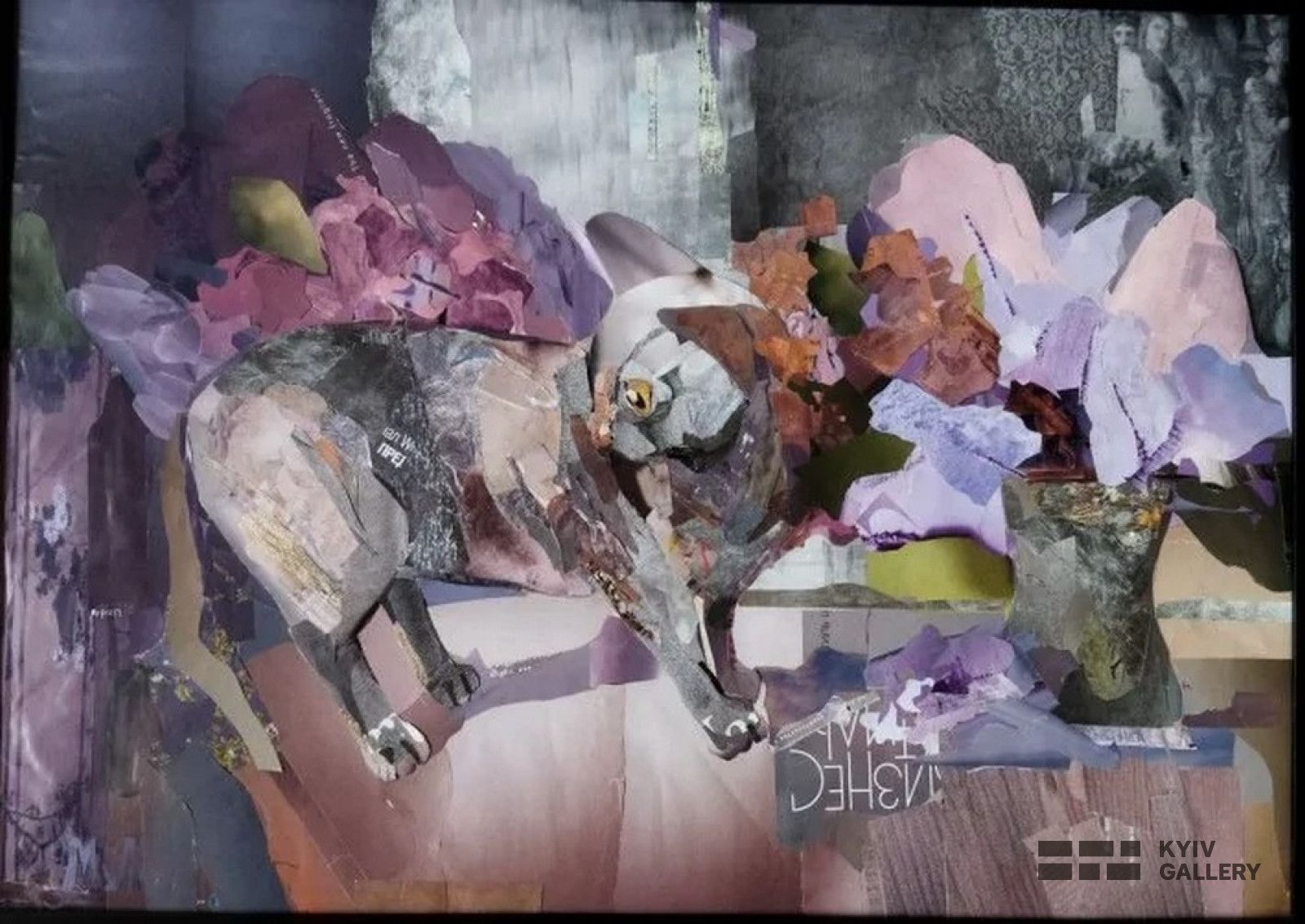

True love for art is impossible without tenderness for the world, plants, and animals. Perhaps that is why among artists, there are so often people with a deep personal connection with our more minor brothers. Purring cats, aggressive dogs, friendly deer, and even eccentric anteaters appear in paintings in the style of animalism. For some artists, they became not only pets but also a kind of totem animals in the image of which the artists see themselves. We have collected the most exciting stories of friendship between our four-legged pets and masters of painting.
Cats
Several thousand years ago, cats crept into people's homes and settled there forever. It is hard to find someone who would resist the charm of fluffy lumps of happiness. Unsurprisingly, they managed to find their way to artists' studios and take a decent first place among all pets.
The cat world of Louis Wayne
Art historians suggest that the obsession of the famous illustrator of the XIX-XX centuries, Louis Wayne, with cats resulted from schizophrenia. Perhaps it was, but this does not diminish the pleasure of contemplating anthropomorphic furry animals on the pages of books for children and adults.
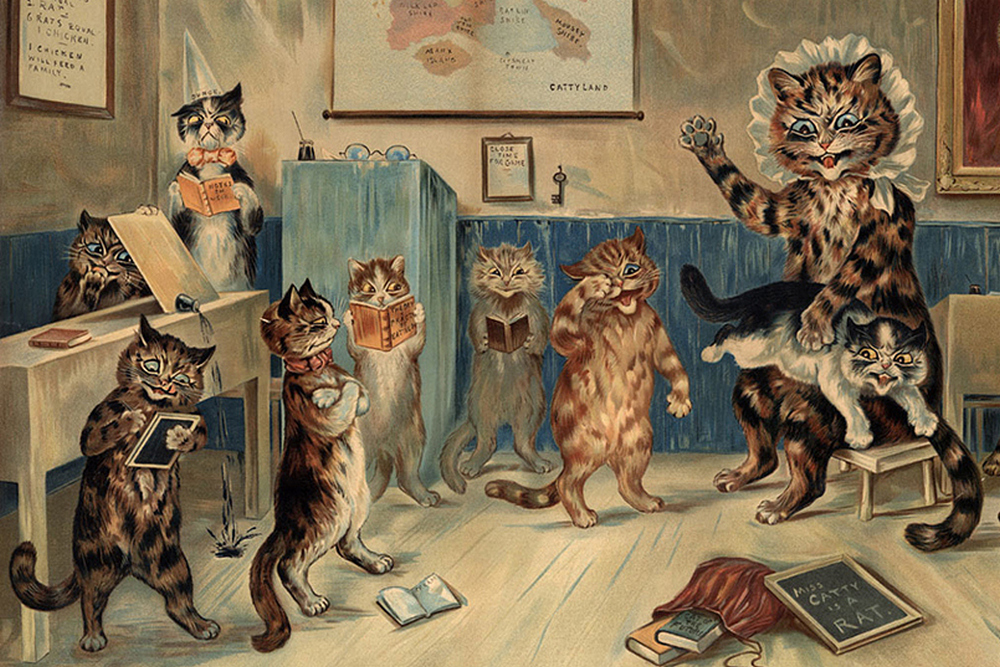
Louis Wayne. Photos © lumos.art
Love for domestic animals was not limited to the sphere of art: Wayne kept cats in his house, was the president of the National Cat Club, and volunteered for charitable organizations. If his wards could draw, they would paint a portrait of their patron. The master's passion for the idea of creating new images became the reason for the emergence of the actual cat world.
Cats by Franz Marc
German expressionist Franz Marc considered people ugly, so the object of his attention was mainly animals. In addition to all kinds of horses, foxes, and roes, painted by Mark during his short life, there are lovely paintings dedicated to cats. The famous "White Cat" shows the viewer that the author of the canvas had the opportunity to observe fluffy cats in their natural environment. The pet calmly rests on a yellow pillow, slightly curled up in a ball. We do not know the name of this tailed cotton, but it is clear that for the artist, it is not some street cat model but a good old friend.
Ramin by Suzanne Valadon
The story of artist Suzanne Valadon is awe-inspiring. Being the illegitimate daughter of a washerwoman, she managed first to become a favorite model of the Parisian impressionists of the late XIX century and then an artist. For a long time, Suzanne did not dare to provide the public with the results of her searches. But then she showed some sketches to Henri Toulouse-Lautrec, for whom she had worked as a model before. From that moment, she joined the community of Parisian masters of painting and began to actively paint in various genres.
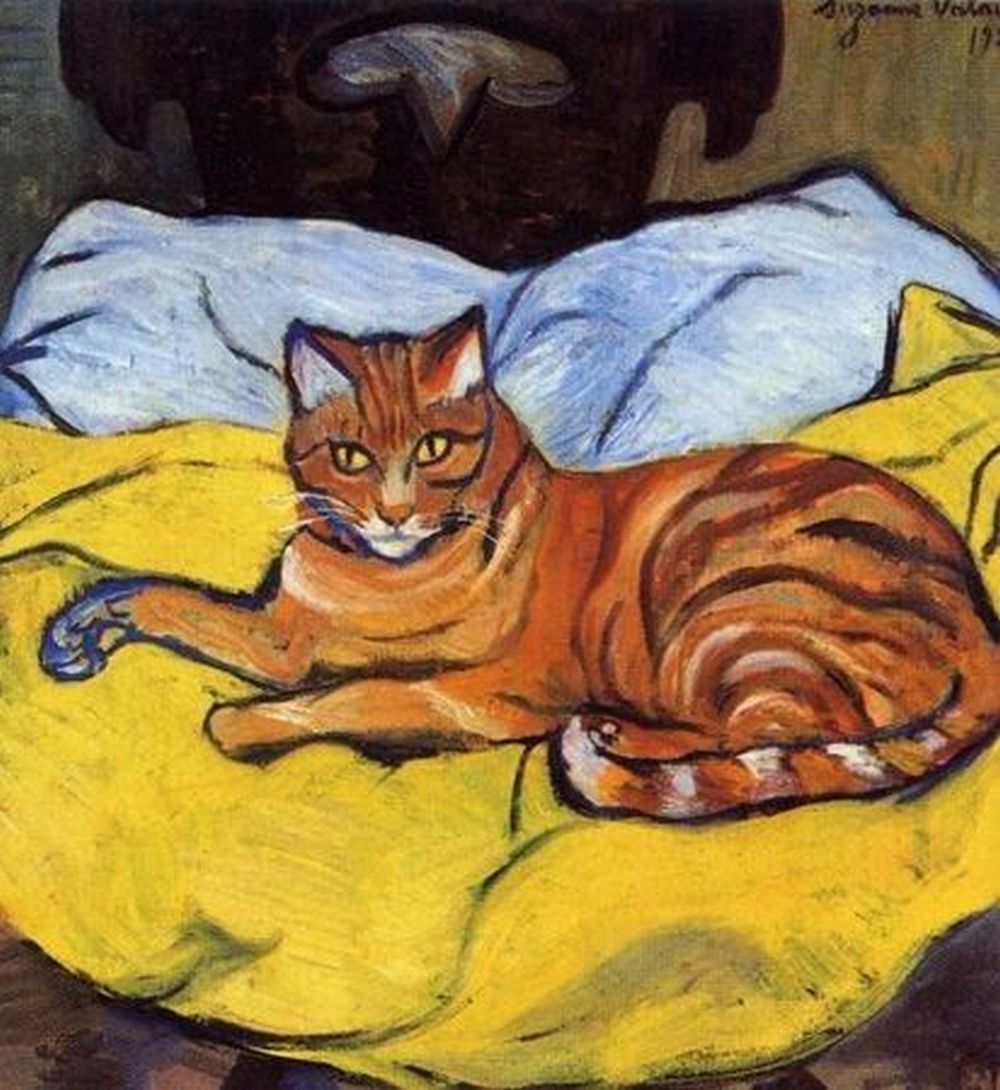
«Ramin» Suzanne Valadon. Photos © pinterest.com
Among the beautiful portraits of Valadon's brush, you can find several works dedicated to her beloved cat, an exotic name Ramin. Warm colors and attention to the minor details of the cat's face suggest to us that this fluffy cat played an essential role in the life of a strong and independent woman.
Feline passions of Picasso
The French artist of Spanish origin was a great admirer of domestic animals. Birds, dogs, cats, and other animals lived in his house for many years. Dozens of outbred cats, pampered by their owner's attention, found shelter in the villa of the master. We do not know their names exactly, but we can see them in such paintings as "Cat Eating a Bird," "Cat and Lobster," and "Woman Lying Down Playing with a Cat." As if jokingly, Picasso said that we see cats almost always pregnant on the street because "they only think about love."
Japanese cat illustrator Utagawa Kuniosi
The illustrator from the distant Land of the Rising Sun became popular among students in his younger years due to his love for cats. Fluffy creatures overflowed the studio, so it is not surprising that such a passion found its continuation in creativity. In Utagawa Kuniosi's prints, cats are often depicted instead of characters from Japanese folklore. He created an excellent work, "55 cats", in which it is easy to guess the collection of prints by Ukiyo-e, "Fifty-three stations of Tokaido." Through the prism of cat puns, Kuniosi depicted the Eastern Sea Road with stations and accommodations for travelers.
Ai Weiwei and 40 cats
One of the most influential contemporary Chinese masters, Ai Weiwei, is known for his love for the feline family. He regularly posts photos of his favorite pets on the social network. In one of his interviews, Weiwei claimed that furry pets feel like masters in his studio. According to the master, the constant bustle in the backyard makes him a happy man.
Dogs
Along with cats, dogs are popular among artists. The devotion and simplicity of four-legged pets inspire the creativity of masters at any age. Being by nature, more friendly dogs usually take an active part in the life of their owners.
Archie by Andy Warhol
In 1973, a small four-legged creature with no athletic physique appeared in the house of the king of pop art. Soon a tiny dachshund named Archie became the most beloved friend of Andy Warhol, with whom he visited restaurants, workshops, and exhibitions.
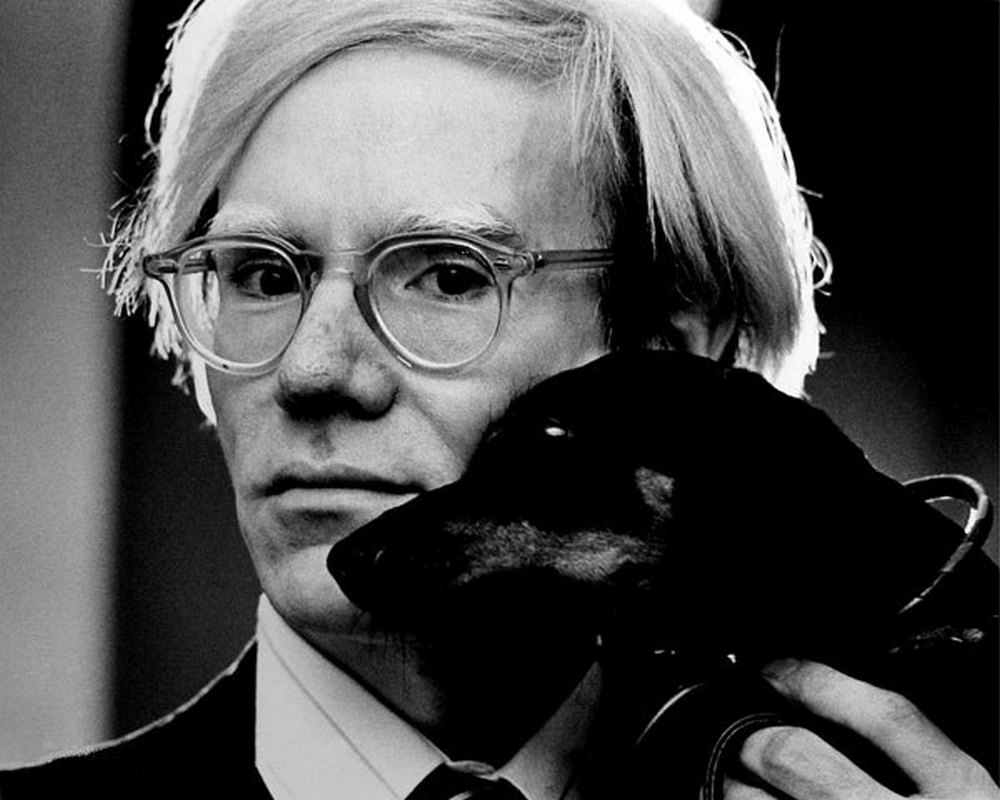
Andy Warhol and Archie. Photos © dic.academic.ru
The artist's connection with his pet was so strong that he refused to fly to London without him. In social life, Archie became an alter ego of the artist. Sometimes in interviews, Warhol even redirected some questions to the taxi.
Dog in the snow by Franz Marc
In addition to cats, the famous artist Franz Marc also loved dogs. According to experts of the Stendel Museum in Frankfurt am Main, the painting "Dog Lying in the Snow" depicts his pet. In 2008 it became the most popular exhibit among visitors. Franz Marc not only loved animals but also passionately experienced their suffering. Traces of this tragic worldview remained on the canvas: all four-legged looked sad.
Snoopy by Charles Schulz
Not everyone knows that the character of the Peanuts comic strip by cartoonist Charles Schulz was created in memory of a small dog named Spike, with whom he grew up as a child. He had a strange habit of swallowing various objects. Everything was used, from small balls to nails. Despite such a diet, the dog remained healthy after such food. At age 15, Schultz drew her and sent her to the show "Believe it or not."
Lucien Freud's hound
Known for his manner of depicting mutilated human bodies, Lucien Freud dedicated several works to his beloved hound named Pluto. Unlike people, the dog was depicted on canvases without distortion. Later, the artist, commenting on the appearance of animals on the canvases, said that he was amazed by their lack of arrogance and readiness for action, which he called "pragmatism."
Exotic animals
In addition to traditional cats and dogs for our homes, the masters often had more exotic pets. Some of them lived in cages and saw the owner far from the eyes of strangers, while others accompanied the artists everywhere in public.
Salvador Dali's Babu
Eccentric Salvador Dali loved animals, but the desire for shock did not allow him to have "ordinary" pets. Excellent proof of this - photos from public events, where the master poses with his favorite ocelot (dwarf leopard), Babu.
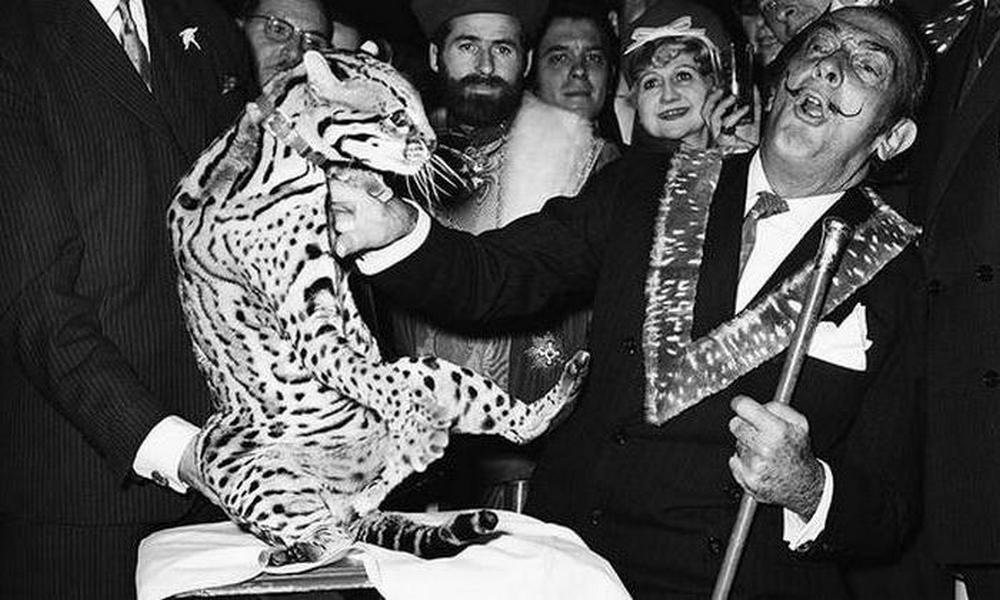
Salvador Dali and Babu. Photos © kulturologia.ru
Dali acquired the exotic pet in the 1960s, and since then, he has not parted with it, even while walking around the city. The master of surrealism liked to tell a story about visiting a restaurant in Manhattan, where visitors were very concerned about the appearance of such an unusual animal. But Babu hardly wanted such a life. Carlo Lozano wrote in his memoirs that he saw the ocelot happy only once, when it escaped from the owner's room and scared the hotel staff.
Anteater by Salvador Dali
The ocelot is by no means the only exotic animal that Salvador Dali loves. The famous Spaniard first showed the world his anteater in 1969 during a walk in the Paris subway. The next day, the whole press discussed the renowned painter's pet, wondering if the maestro had gone crazy. The reasons for choosing a new friend were no less surprising than the pet itself. It turns out that in childhood Dali had a bat at home. After its death, the boy discovered that ants were crawling on the tiny body, and since then, he did not like ants. Fortunately, the animal was not taken from the wild because the artist just took care of the anteater from the Paris zoo. According to the artist's logic, an anteater is a kind of destroyer of something terrible. And it is for this reason that Dali chose it.
Rossetti's wombat
Pre-Raphaelite Dante Gabriel Rossetti loved unusual animals. One such exotic pet was a wombat from Australia named Top. The animal was not dangerous to others but had a very peculiar character. For example, he could sleep peacefully on the dining table during the meal. After the death of the wombat, Rossetti dedicated an epitaph and several drawings to it.
Frida Kahlo's Gonzo
The artist Frida Kahlo had monkeys, parrots, and a bald dog of an unusual breed as pets. But the most beloved for her was a small deer named Gonzo. He was both a source of inspiration and a model of paintings. For example, in 1946, the public was presented with the canvas "Wounded Deer," on which a deer wounded by arrows with Kahlo's face jumps in the forest. In this way, she expressed all her pain for the suffering of wildlife and adapted it for the viewer's perception, demonstrating the unity of the beast and man.
KyivGallery art critic
